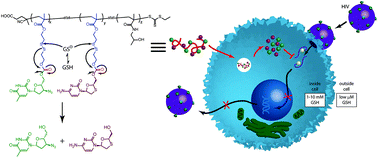Combination anti-HIV therapy via tandem release of prodrugs from macromolecular carriers†
Abstract
Reversible addition-fragmentation chain transfer (RAFT) polymerisation has been used to create a library of copolymers outfitted with a combination of self-immolative reverse transcriptase inhibitor prodrug pendents comprising zidovudine (AZT) and lamivudine (3TC). Self-immolative prodrug monomers were explored and compared from which a prefered route with greatest overall yield was determined. 1H-NMR studies demonstrated that triggered, simultaneous drug release from copolymers was achieved when incubated with glutathione (GSH). HIV replication assays revealed that potency increased with polymer molar mass. Copolymers with both AZT and 3TC pendents exhibited potencies close to the potency of unconjugated AZT alone indicating that potency cannot be explained by additive effects. Treatment of this potency data with a Chou and Talalay combination model revealed combination indices indicative of synergistic effects. The polymers represent a new class of polymer therapeutic that is anticipated to lead to a higher circulation lifetime than the unconjugated prodrugs. As such, these copolymers are envisioned to be highly conducive as anti-HIV therapeutics by facilitating simultaneous release of two antiretroviral inhibitors to be taken up by infected tissue.



 Please wait while we load your content...
Please wait while we load your content...